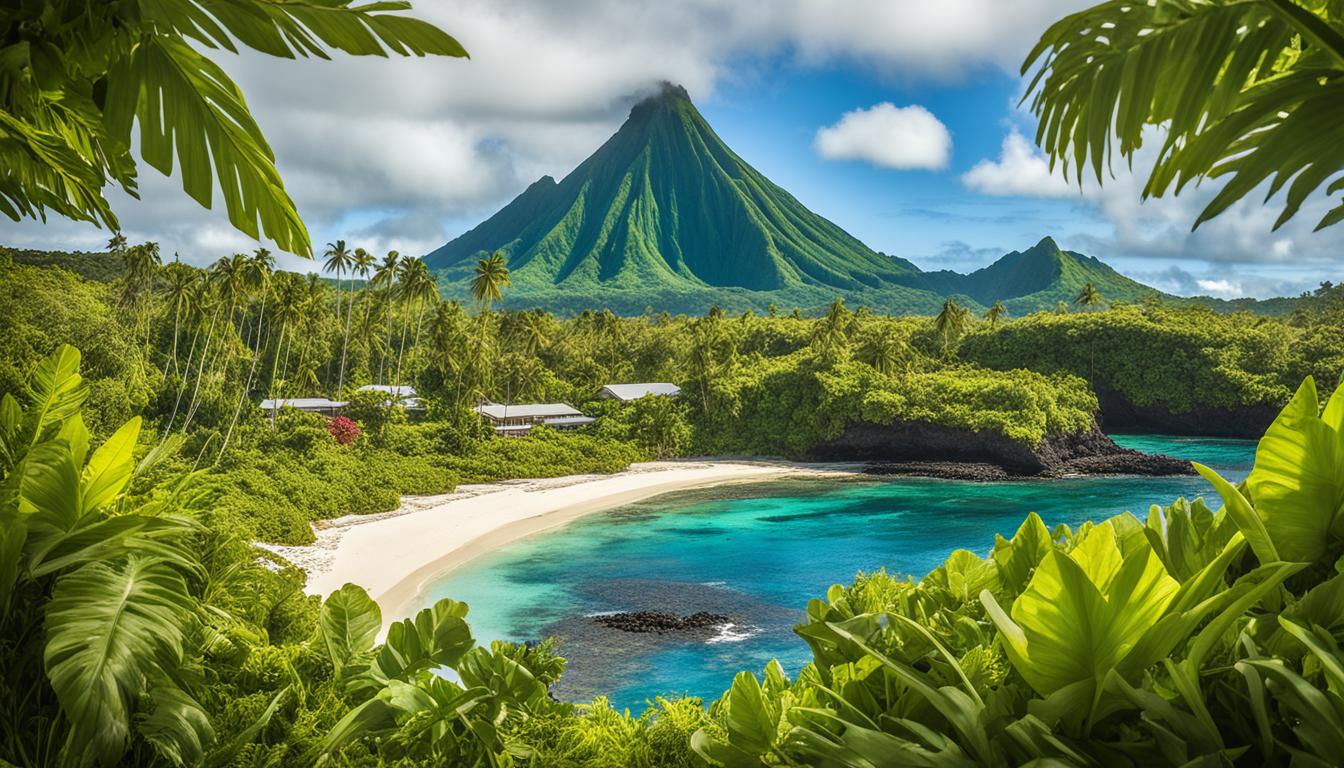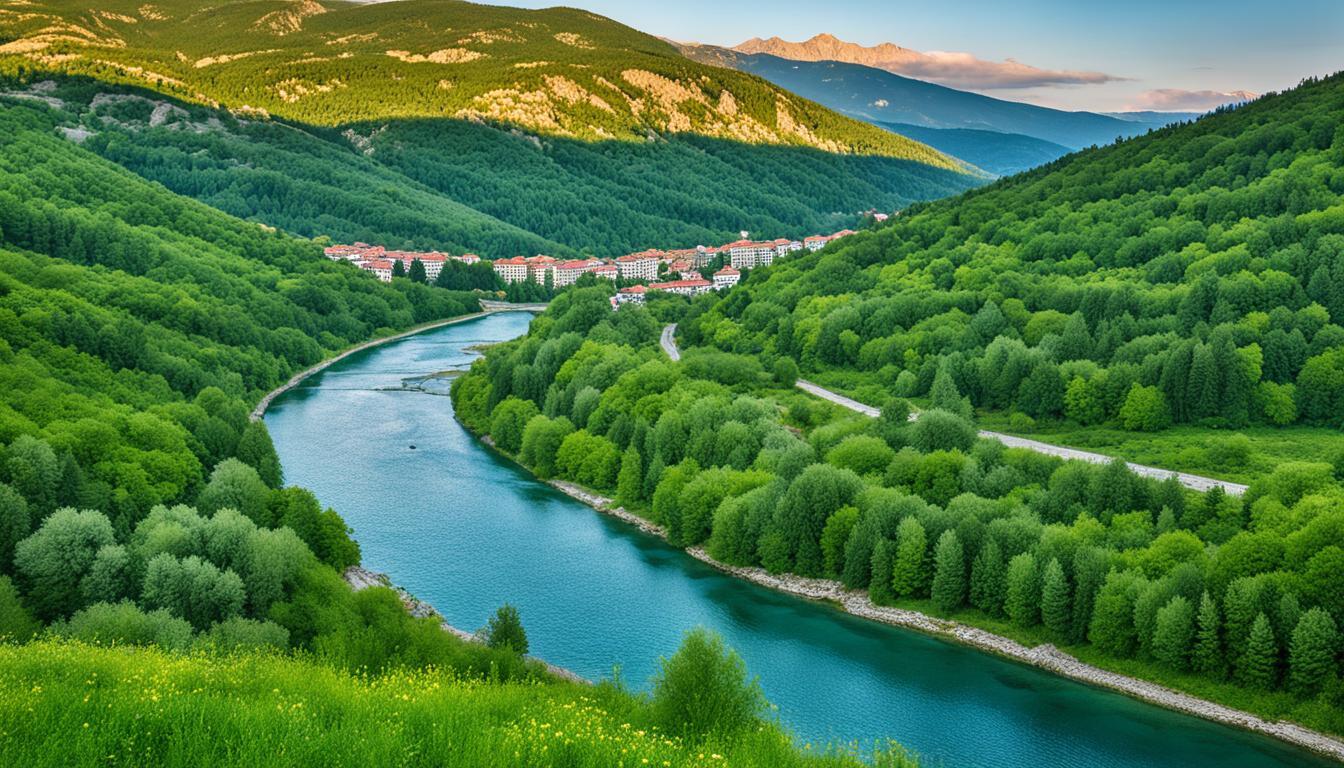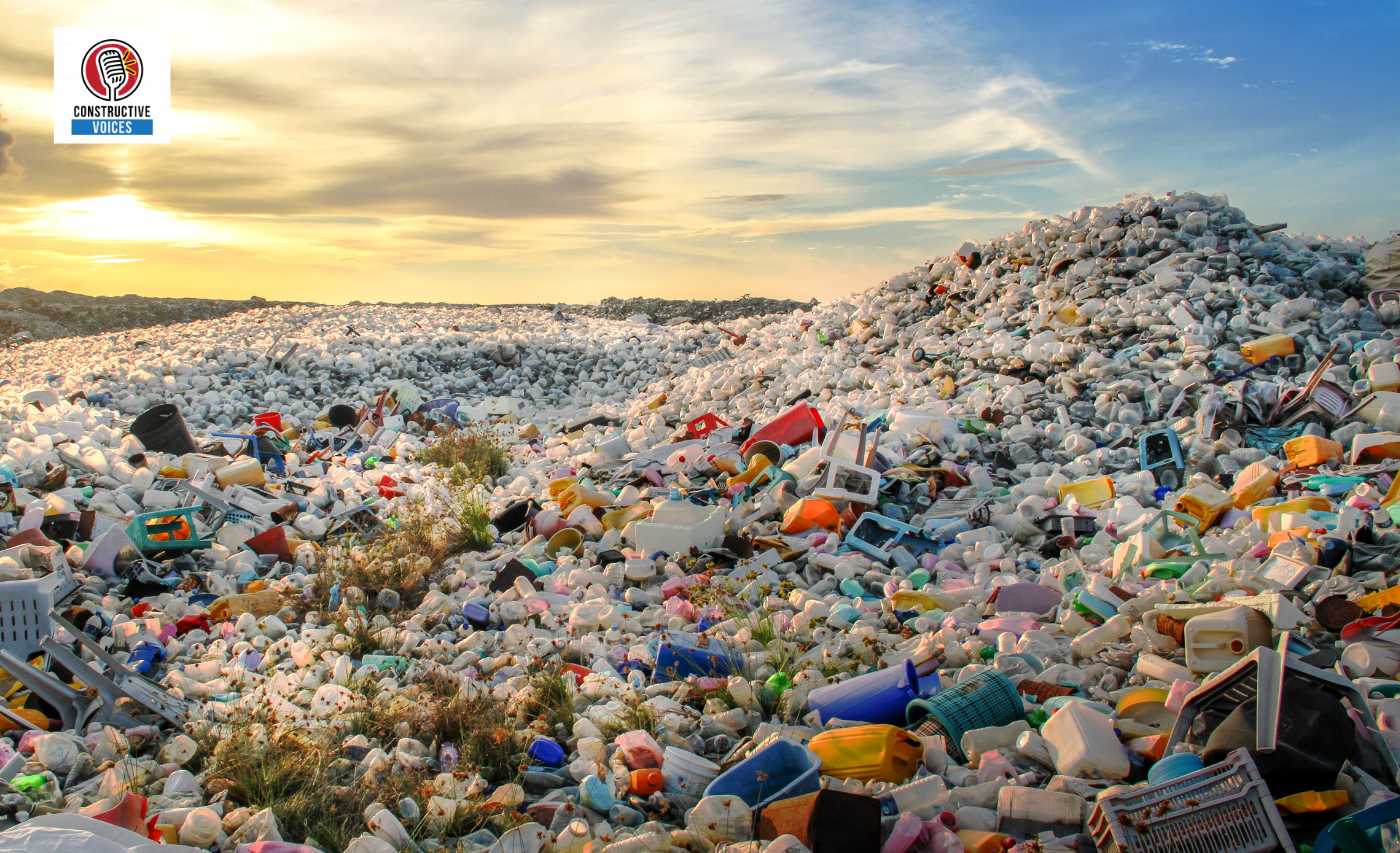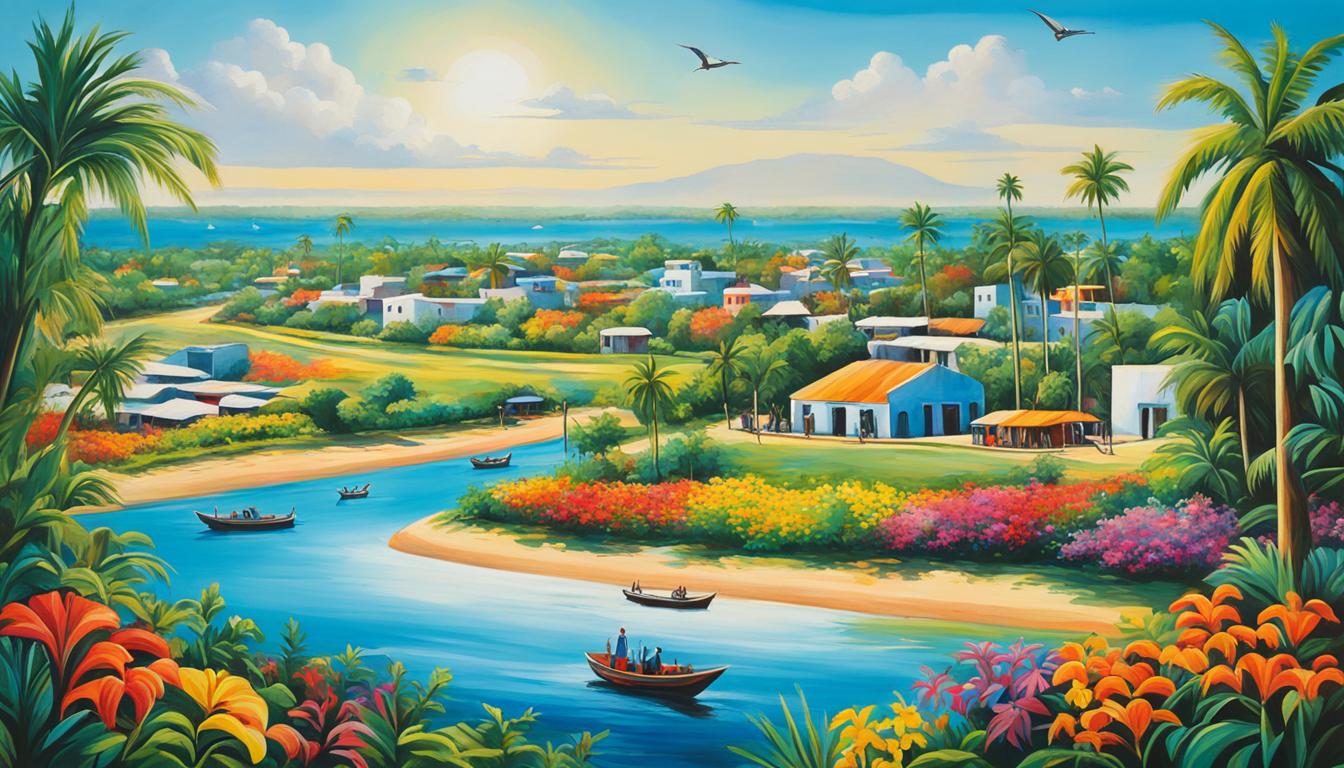Saint Vincent and the Grenadines Biodiversity and the Built Environment
Did you know that Saint Vincent and the Grenadines, a small archipelagic nation in the Eastern Caribbean, is home to an astonishing array of biodiversity? With over 1,150 species of flowering plants, 17 mammal species, 190 bird species (including 2 island endemics), 21 reptile species (including 5 endemics), and more than 500 marine species, the ecological diversity of this country is truly remarkable.
However, despite its natural wealth, Saint Vincent and the Grenadines faces threats to its biodiversity from habitat loss, invasive species, and unsustainable practices. In this article, we will explore the importance of environmental conservation and sustainable architecture in preserving the natural habitat and promoting the balance between urban development and ecological preservation in Saint Vincent and the Grenadines.
Key Takeaways:
- Saint Vincent and the Grenadines is a biodiverse hotspot with a rich array of plant and animal species.
- The country faces threats to its biodiversity from habitat loss, invasive species, and unsustainable practices.
- Environmental conservation and sustainable architecture play a crucial role in preserving the natural habitat and promoting sustainable development.
- By integrating green building practices and environmentally-friendly infrastructure, Saint Vincent and the Grenadines can protect its biodiversity while ensuring the well-being of its communities.
- Efforts to preserve biodiversity in Saint Vincent and the Grenadines require a collaborative approach and the involvement of local communities.
Flora and Fauna of Saint Vincent and the Grenadines
Saint Vincent and the Grenadines is renowned for its extraordinary ecological diversity, showcasing a remarkable variety of flora and fauna. The country is home to over 1,150 species of flowering plants, which includes 16 endemics. The lush landscapes boast 163 species of ferns, with 4 endemic to the region.
The marine biodiversity in Saint Vincent and the Grenadines is equally captivating. The crystal-clear waters house over 500 species of finfish, including enchanting creatures like whales, dolphins, and turtles. The marine ecosystems are further enriched by a diverse array of gastropods, seaweed, and corals. These natural treasures make Saint Vincent and the Grenadines a true hotspot for marine biodiversity.
The exceptional species richness found in Saint Vincent and the Grenadines contributes to its status as a biodiversity hotspot. Endemic species, unique to this region, add to the charm and exclusivity of the country’s natural heritage.
Key Features of Saint Vincent and the Grenadines Biodiversity:
- Over 1,150 species of flowering plants
- 163 species of ferns, including 4 endemics
- 500+ species of finfish, with 12 species of whales and dolphins
- 4 species of turtles
- 9 species of gastropods
- 11 species of seaweed
- 30 species of corals
The abundance and diversity of the flora and fauna in Saint Vincent and the Grenadines are testament to the pristine beauty of its natural landscapes. Preserving and protecting this rich biodiversity is crucial for the welfare and conservation of future generations.
Threats to Biodiversity in Saint Vincent and the Grenadines
Despite its rich biodiversity, Saint Vincent and the Grenadines face various threats to their delicate ecosystems. These threats include habitat loss, deforestation, invasive species, unsustainable agricultural practices, forest fires, sand mining, destructive harvesting practices, and the introduction of invasive alien species. Notably, habitat loss is a significant concern as it leads to the degradation and fragmentation of natural habitats, reducing the available resources for native species to thrive.
Invasive species pose a substantial threat to biodiversity in Saint Vincent and the Grenadines. These non-native plants, animals, and pathogens often outcompete native species for resources, disrupt ecological balance, and threaten the survival of indigenous plants and animals. Their introduction and spread are primarily driven by human activities, such as international trade and transportation.
Unsustainable agricultural practices in the region contribute to biodiversity loss and habitat degradation. The excessive use of chemicals, the conversion of natural habitats into agricultural land, and the irresponsible management of agrochemical waste negatively impact the environment and the species that depend on it.
Natural threats, including volcanic eruptions, tropical cyclones, droughts, and landslides, further impact the fragile forest ecosystems of Saint Vincent and the Grenadines. These events can cause significant destruction, leading to the loss of habitat and disruption of ecosystem processes.
The marine ecosystems of the country also face critical threats. Unsustainable coastal and marine resource use, overfishing, coastal habitat destruction, and pollution from land-based and boat sources degrade the marine environment, jeopardizing the diversity of marine species and the overall health of the ecosystem.
Climate change poses an additional risk, particularly through coral bleaching events. Rising sea temperatures and ocean acidification result in the loss of symbiotic algae, causing coral reefs to bleach and become more susceptible to disease and death. Coral reefs are vital for marine biodiversity and provide essential ecosystem services, making their decline a significant concern for conservation efforts.
The combination of these threats to biodiversity jeopardizes the delicate balance of the ecosystems in Saint Vincent and the Grenadines. It puts numerous species at risk of extinction and undermines the overall health and resilience of the environment.
Key Threats to Biodiversity:
| Threat | Description |
|---|---|
| Habitat Loss | Resulting from deforestation, land conversion, and fragmentation, reducing resources for native species. |
| Invasive Species | Non-native plants, animals, and pathogens outcompete native species and disrupt ecological balance. |
| Unsustainable Agricultural Practices | Excessive use of chemicals, land conversion, and mismanagement of agrochemical waste impact biodiversity. |
| Natural Threats | Volcanic eruptions, tropical cyclones, droughts, and landslides disrupt forest ecosystems. |
| Unsustainable Coastal and Marine Resource Use | Overfishing, coastal habitat destruction, and pollution degrade marine ecosystems. |
| Climate Change | Coral bleaching due to rising sea temperatures and ocean acidification threatens coral reef ecosystems. |
Addressing these threats and implementing effective conservation measures are crucial for the long-term preservation of biodiversity in Saint Vincent and the Grenadines. It requires collective efforts from government bodies, local communities, and international organizations to mitigate the impacts, promote sustainable practices, and safeguard the unique ecosystems for future generations.
Conservation Efforts in Saint Vincent and the Grenadines
Saint Vincent and the Grenadines have implemented various conservation efforts to protect their biodiversity. The country has established wildlife reserves, marine conservation areas, forest reserves, and marine parks to safeguard habitats and species. These protected areas cover a significant portion of the country’s marine, terrestrial, and freshwater habitats.
The National Biodiversity Strategy and Action Plan (NBSAP) guides the implementation of conservation measures and promotes sustainable development. The country also emphasizes the importance of preserving its natural heritage and supports wildlife conservation initiatives. These conservation efforts aim to preserve the diverse ecosystems found in Saint Vincent and the Grenadines, ensuring the long-term preservation of biodiversity.
Here is an overview of the different types of protected areas:
| Protected Area | Type |
|---|---|
| Wildlife Reserves | Terrestrial protected areas dedicated to the conservation of native wildlife species. |
| Marine Conservation Areas | Designated marine areas aimed at preserving marine ecosystems and biodiversity. |
| Forest Reserves | Protected forest areas that safeguard valuable forest ecosystems and habitats. |
| Marine Parks | Specific marine areas managed to protect and conserve marine species and their habitats. |
These conservation efforts reflect Saint Vincent and the Grenadines’ commitment to sustainable development and the preservation of its natural environment. By conserving and protecting their biodiversity, the country ensures the continued existence of unique species and ecosystems for future generations.

Forest Conservation in Saint Vincent and the Grenadines
Saint Vincent and the Grenadines are blessed with approximately 29% of tropical forest cover, which encompasses a wide range of diverse ecosystems. These include primary and secondary rainforests, palm brakes, elfin woodlands, littoral woodlands, dry scrub woodlands, and mangrove forests. However, the country has experienced a significant decline in forest cover due to deforestation, resulting in an estimated 10% decrease between 1949 and 1993. To address this pressing issue, Saint Vincent and the Grenadines have adopted proactive measures, including reforestation and conservation forestry interventions, to restore and sustainably manage its forests.
The aim of these efforts is not only to protect the invaluable biodiversity of these forest ecosystems but also to preserve the natural heritage of the nation. Reforestation initiatives play a crucial role in reversing the damage caused by deforestation, helping to rebuild the forest ecosystem and provide a habitat for diverse wildlife species. By implementing sustainable practices and carefully managing the forests, Saint Vincent and the Grenadines strive to ensure the long-term preservation of its natural resources.
The Importance of Forest Conservation
Forest conservation in Saint Vincent and the Grenadines serves multiple purposes. Firstly, these forests are essential in maintaining the ecological balance of the region, as they provide habitat and food sources for a wide variety of plant and animal species. The diverse range of ecosystems found within the forests support a rich array of flora and fauna, including endangered and endemic species. Protecting and preserving these habitats is crucial for the conservation of biodiversity and the overall health of the environment.
Furthermore, the forests play a vital role in mitigating climate change and reducing carbon dioxide emissions. Through the process of photosynthesis, trees absorb carbon dioxide from the atmosphere and store it, helping to reduce the greenhouse effect. Maintaining and expanding forest cover is crucial for the global effort to combat climate change and promote sustainability.
Forest conservation also contributes to sustainable livelihoods and economic development. Forests provide valuable resources such as timber, non-timber forest products, and ecosystem services that support local communities. By managing forests sustainably, Saint Vincent and the Grenadines can ensure a continuous supply of these resources while minimizing the negative impacts on the environment.
Reforestation Efforts in Saint Vincent and the Grenadines
Reforestation plays a significant role in restoring and conserving the forest ecosystems in Saint Vincent and the Grenadines. The government, along with various organizations and community initiatives, has been actively involved in reforestation projects. These projects involve planting native tree species and implementing sustainable land management practices to enhance forest regeneration and ensure long-term sustainability.
In the words of Sir David Attenborough, “Every well-planted tree acts as a carbon sink, and every forested acre is a natural solution to climate change. Reforestation efforts in Saint Vincent and the Grenadines are crucial for preserving biodiversity, mitigating climate change, and promoting sustainable development.”
Reforestation initiatives not only focus on restoring primary rainforests but also emphasize the importance of nurturing secondary forests and other forested ecosystems. These efforts aim to create a mosaic of forest habitats that can support a diverse range of plant and animal species.
Forest Cover and Conservation Efforts in Saint Vincent and the Grenadines
| Forest Type | Percentage of Forest Cover | Conservation Efforts |
|---|---|---|
| Primary Rainforests | XX% | Implementation of strict protected areas, restoration projects |
| Secondary Rainforests | XX% | Community-led reforestation initiatives, sustainable land management practices |
| Other Forest Ecosystems (e.g., palm brakes, elfin woodlands, littoral woodlands, dry scrub woodlands, mangrove forests) | XX% | Conservation measures to protect specific habitats and species |
The table above summarizes the forest cover and conservation efforts in Saint Vincent and the Grenadines. It highlights the importance of protecting primary and secondary rainforests, as well as other forest ecosystems, through various conservation initiatives.
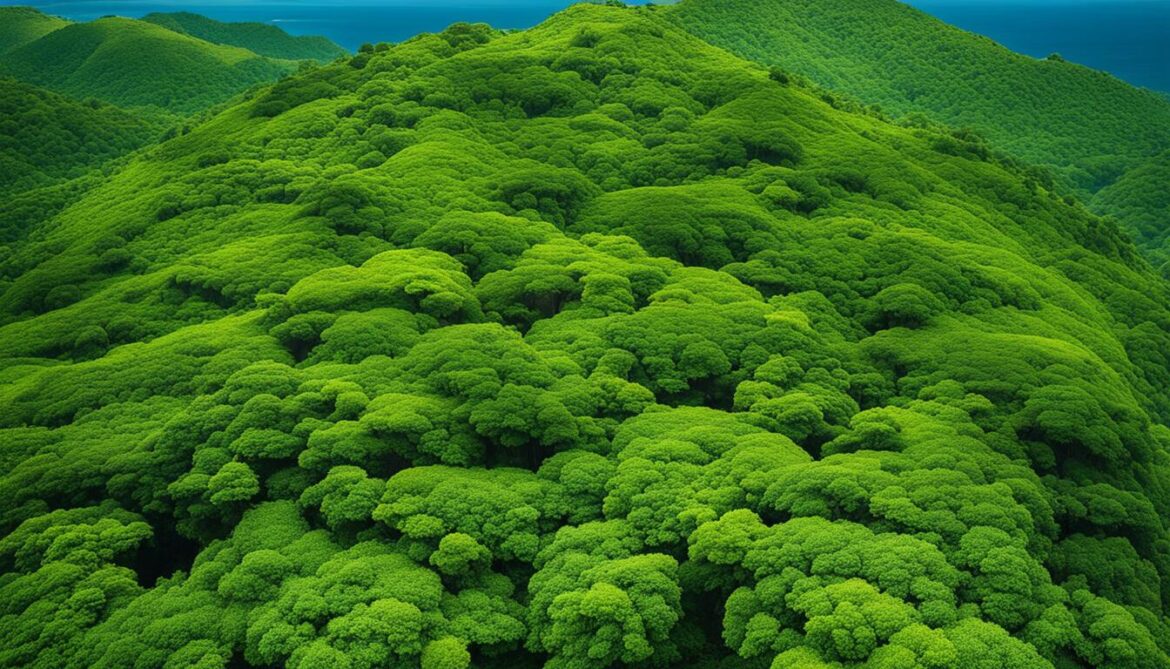
Forest conservation is a critical component of biodiversity preservation and sustainable development in Saint Vincent and the Grenadines. By promoting reforestation and implementing effective conservation strategies, the country endeavors to ensure the protection of wildlife and the preservation of its natural heritage for future generations.
Marine Conservation in Saint Vincent and the Grenadines
Saint Vincent and the Grenadines are blessed with diverse marine ecosystems that support a wide array of species. To safeguard the rich marine biodiversity, the country has implemented robust marine conservation measures, including the establishment of marine conservation areas, marine parks, and marine reserves. These designated areas cover a significant portion of the country’s marine habitats and play a pivotal role in protecting fish species, corals, marine mammals, and other marine organisms.
The marine conservation areas in Saint Vincent and the Grenadines serve as vital sanctuaries, forming a protective buffer against various threats to the marine environment. Efforts are underway to tackle pressing challenges such as overfishing, coastal habitat destruction, pollution, and the impacts of climate change. By implementing these conservation measures, Saint Vincent and the Grenadines aim to uphold their commitment to preserving marine biodiversity and ensuring the sustainability of their coastal communities.

The Importance of Marine Ecosystems
Marine ecosystems in Saint Vincent and the Grenadines are invaluable as they provide numerous ecological, economic, and social benefits. Coral reefs, often referred to as the rainforests of the sea, support a diverse array of marine life, including colorful fish, sea turtles, and delicate coral species. These vibrant ecosystems not only contribute to the country’s marine biodiversity but also attract tourists, supporting the local economy.
Beyond coral reefs, Saint Vincent and the Grenadines boast other critical marine habitats, such as sea grass beds and mangroves. Sea grass beds serve as nurseries for various fish species, while mangroves act as important coastal buffers, protecting against erosion and providing a haven for birds and other wildlife. It is essential to preserve these marine ecosystems to maintain their ecological integrity and the services they provide.
The Challenges of Marine Conservation
Marine conservation in Saint Vincent and the Grenadines faces a range of challenges. Overfishing, driven by unsustainable practices and the demand for seafood, depletes fish populations and disturbs the delicate balance of marine ecosystems. Coastal habitat destruction, particularly the destruction of coral reefs, diminishes essential habitats and reduces the resilience of these ecosystems to climate change impacts.
“Marine conservation areas, marine parks, and marine reserves play a vital role in protecting fish species, corals, marine mammals, and other marine organisms”
Another significant challenge is pollution, both from land-based sources and marine vessels. Pollution degrades water quality, posing risks to marine life and compromising the health of coral reefs, sea grass beds, and mangroves. The impacts of climate change, including rising sea temperatures and ocean acidification, further threaten marine ecosystems, contributing to coral bleaching events and altering the delicate balance of these habitats.
The Future of Marine Conservation in Saint Vincent and the Grenadines
The future of marine conservation in Saint Vincent and the Grenadines lies in continued collaborative efforts and comprehensive management strategies. It is crucial to strengthen monitoring and enforcement mechanisms to ensure the effectiveness of marine conservation areas and parks. Engaging local communities and stakeholders is key to promoting sustainable fishing practices, reducing coastal pollution, and raising awareness about the importance of marine conservation.
Furthermore, integrating climate change adaptation and mitigation strategies into marine conservation plans will enhance the resilience of marine ecosystems. This includes promoting sustainable coastal development practices and reducing greenhouse gas emissions. By prioritizing the protection and sustainable use of marine resources, Saint Vincent and the Grenadines are working towards a future where marine biodiversity flourishes and coastal communities thrive.
Sustainable Development and Biodiversity Conservation in Saint Vincent and the Grenadines
Saint Vincent and the Grenadines recognize the importance of balancing biodiversity conservation with sustainable development. The National Biodiversity Strategy and Action Plan (NBSAP) aims to integrate biodiversity conservation into national planning processes and promote the sustainable use of biological resources.
The country is implementing measures to encourage integrated natural resource management, rationalize land use allocation, strengthen conservation at national and local levels, and enhance the capacity for sustainable biodiversity use. By prioritizing sustainable development practices, Saint Vincent and the Grenadines strive to protect their natural heritage while supporting the well-being of their communities.
| Key Measures for Sustainable Development and Biodiversity Conservation |
|---|
| Integration of biodiversity conservation into national planning processes |
| Encouragement of integrated natural resource management |
| Rationalization of land use allocation |
| Strengthening of conservation at national and local levels |
| Enhancement of capacity for sustainable biodiversity use |
By implementing these measures, Saint Vincent and the Grenadines aim to strike a balance between preserving their rich biodiversity and promoting sustainable development. The integration of biodiversity conservation into national planning processes ensures that the protection of natural resources remains a priority in decision-making. Through effective land use planning and management, the country can allocate land for development while safeguarding important habitats and ecosystems.
The strengthening of conservation efforts at national and local levels allows for the establishment and management of protected areas, wildlife reserves, and marine conservation areas. These designated areas play a crucial role in preserving the diverse flora and fauna found in Saint Vincent and the Grenadines.
Furthermore, by enhancing the capacity for sustainable biodiversity use, the country can explore innovative approaches to resource management and find sustainable ways to utilize biological resources without depleting them. This includes promoting sustainable agriculture, eco-tourism, and responsible fishing practices.
In conclusion, sustainable development and biodiversity conservation go hand in hand in Saint Vincent and the Grenadines. Through the implementation of the National Biodiversity Strategy and Action Plan and the adoption of various measures, the country is taking significant steps towards protecting its natural heritage for future generations.
Threats to Forest and Marine Biodiversity in Saint Vincent and the Grenadines
Forest and marine biodiversity in Saint Vincent and the Grenadines are under significant threat, jeopardizing their long-term conservation. Both ecosystems face a multitude of challenges that need to be addressed to ensure the preservation of biodiversity in the region.
Threats to Forest Biodiversity
The forests in Saint Vincent and the Grenadines are facing several threats that contribute to the decline of biodiversity. Limited land use planning leads to unregulated development, resulting in deforestation and habitat loss. The fragmentation of forests exacerbates this issue, further impacting the overall health and resilience of forest ecosystems. Forest fires, often caused by human activities, pose an immediate threat, destroying habitats and disrupting the delicate balance of biodiversity. Unsustainable resource use, such as illegal logging and excessive hunting, also contributes to the degradation of forest ecosystems.
Threats to Marine Biodiversity
The marine ecosystems of Saint Vincent and the Grenadines are also confronted with significant challenges. Overfishing, driven by unsustainable harvesting practices, disrupts the balance of marine food webs and depletes fish populations. Coastal habitat destruction, mainly due to human activities such as dredging, construction, and pollution, further threatens marine biodiversity. Pollution from land-based and boat sources introduces harmful substances into the marine environment, impacting the health of corals, fish, and other marine organisms. The increasing impacts of climate change, particularly coral bleaching events, pose additional risks to fragile coral reef ecosystems, diminishing their capacity to support diverse marine life.
Invasive alien species pose a substantial risk to both forest and marine biodiversity in Saint Vincent and the Grenadines. These species, introduced by human activities, can outcompete native species and disrupt the delicate balance of ecosystems, leading to the decline of local biodiversity.
To ensure the long-term preservation of biodiversity in Saint Vincent and the Grenadines, it is crucial to address and mitigate these threats. Efforts must focus on sustainable land use practices, including rigorous land use planning and regulations that protect forests from deforestation, habitat loss, and fragmentation. Strict measures should be implemented to combat illegal logging and unsustainable resource use, promoting the conservation of forest ecosystems. In the marine realm, effective fisheries management, including the establishment of no-take marine reserves, can help alleviate the pressure on fish populations and preserve marine biodiversity. Sustainable coastal development practices, such as responsible construction and pollution mitigation measures, are essential to safeguarding coastal habitats and the species that rely on them.

| Threats to Forest Biodiversity | Threats to Marine Biodiversity |
|---|---|
| Habitat loss due to deforestation | Overfishing and unsustainable harvesting practices |
| Fragmentation of forests | Coastal habitat destruction |
| Forest fires | Pollution from land-based and boat sources |
| Unsustainable resource use | Coral bleaching due to climate change |
| Invasive alien species | Invasive alien species |
Implementation of the NBSAP and Conservation Targets in Saint Vincent and the Grenadines
Saint Vincent and the Grenadines has made significant strides in the implementation of the National Biodiversity Strategy and Action Plan (NBSAP) to guide its conservation efforts. By developing a comprehensive national biodiversity policy and integrating biodiversity conservation into national planning processes, the country is proactively working towards protecting its unique ecosystems and promoting sustainable resource use.
Through the NBSAP, Saint Vincent and the Grenadines aims to rationalize land use allocation and enhance the capacity for sustainable biodiversity use. Conservation targets have been set to focus on the protection of critical habitats and the sustainable management of biological resources. The establishment of protected areas, such as wildlife reserves, forest reserves, and marine conservation areas, plays a crucial role in achieving these targets.>
In addition to protected areas, management interventions are being implemented to ensure the long-term conservation of biodiversity. These interventions include measures to mitigate habitat loss, prevent deforestation, and combat invasive species. By addressing these key challenges, Saint Vincent and the Grenadines is actively safeguarding its diverse flora and fauna for future generations.
Conservation Targets in Saint Vincent and the Grenadines
The conservation targets set under the NBSAP focus on preserving the country’s unique ecosystems and species, as well as promoting sustainable resource use. Some of the key conservation targets include:
- Protecting and restoring critical habitats
- Conserving endangered and threatened species
- Promoting sustainable agriculture and forestry practices
- Preventing the introduction and spread of invasive alien species
- Improving the management and effectiveness of protected areas
- Enhancing public awareness and understanding of biodiversity
These targets serve as guiding principles for conservation initiatives in Saint Vincent and the Grenadines, ensuring that the country’s biodiversity is sustainably managed and protected.
Management Interventions
Management interventions are essential for the successful implementation of biodiversity conservation strategies. In Saint Vincent and the Grenadines, several management interventions have been implemented to address key threats and promote sustainable resource use. These interventions include:
- Adopting sustainable land use practices, such as agroforestry and organic farming
- Implementing reforestation programs to restore degraded forest areas
- Establishing invasive species control programs
- Promoting sustainable fishing practices and monitoring fishing activities
- Developing monitoring and assessment frameworks to evaluate the effectiveness of conservation efforts
These management interventions aim to mitigate the impacts of habitat loss, invasive species, and unsustainable resource use, contributing to the overall conservation objectives in Saint Vincent and the Grenadines.

Conservation Targets and Management Interventions Table
| Conservation Targets | Management Interventions |
|---|---|
| Protecting and restoring critical habitats | Implementing reforestation programs |
| Conserving endangered and threatened species | Establishing invasive species control programs |
| Promoting sustainable agriculture and forestry practices | Adopting sustainable land use practices |
| Preventing the introduction and spread of invasive alien species | Developing monitoring and assessment frameworks |
| Improving the management and effectiveness of protected areas | Promoting sustainable fishing practices |
| Enhancing public awareness and understanding of biodiversity | Implementing educational and outreach programs |
By setting conservation targets and implementing management interventions, Saint Vincent and the Grenadines is taking proactive steps to protect its biodiversity and ensure the sustainable use of its biological resources.
Key Challenges and Future Perspectives for Biodiversity Conservation in Saint Vincent and the Grenadines
Biodiversity conservation in Saint Vincent and the Grenadines faces several key challenges that require immediate attention and proactive measures. These challenges include limited land use planning, unsustainable practices, habitat loss, invasive species, and the impacts of climate change. To ensure the long-term preservation of biodiversity, it is crucial for the country to prioritize sustainable development practices and integrate biodiversity conservation into national planning processes.
Saint Vincent and the Grenadines should focus on cultivating a sense of community involvement and engagement in conservation efforts. By fostering collaboration among government bodies, local communities, and environmental organizations, the country can work towards a shared goal of preserving its precious biodiversity for future generations.
Increasing awareness about the importance of biodiversity conservation is also essential. Educational initiatives, public outreach programs, and awareness campaigns can help instill a sense of responsibility and encourage individuals to actively participate in conservation efforts. By empowering the local communities and ensuring their active involvement, Saint Vincent and the Grenadines can establish a strong foundation for sustainable development.
Saint Vincent and the Grenadines has the potential to build a sustainable future that balances the needs of the built environment with the preservation of its rich biodiversity. By implementing effective conservation strategies, fostering community involvement, and raising awareness, the country can overcome the challenges it faces and pave the way for a brighter future.
Future Perspectives
Looking ahead, Saint Vincent and the Grenadines should strive to achieve sustainable development goals that integrate biodiversity conservation, natural resource management, and land use planning. By incorporating these aspects into policy frameworks, the country can ensure that its development is in harmony with nature.
It is also crucial for Saint Vincent and the Grenadines to establish clear conservation targets and monitor progress towards their achievement. Regular assessments and evaluations will provide insights into the effectiveness of conservation strategies and identify areas for improvement.
Additionally, the country should explore innovative approaches to biodiversity conservation. This could involve the use of technology, such as remote sensing and data analytics, to monitor and manage ecosystems more effectively. Embracing sustainable practices, such as eco-tourism and sustainable agriculture, can also contribute to both conservation and economic development.
By taking these key challenges into account and adopting a holistic approach to biodiversity conservation, Saint Vincent and the Grenadines can secure a sustainable future where the built environment coexists harmoniously with its unique and diverse ecosystems.

| Key Challenges | Future Perspectives |
|---|---|
| 1. Limited land use planning | 1. Integration of biodiversity conservation into policy frameworks |
| 2. Unsustainable practices | 2. Establishment of clear conservation targets |
| 3. Habitat loss | 3. Adoption of innovative approaches to conservation |
| 4. Invasive species | 4. Use of technology for better ecosystem management |
| 5. Impacts of climate change | 5. Promotion of sustainable practices, such as eco-tourism |
Conclusion
Saint Vincent and the Grenadines showcase an extraordinary blend of biodiversity and diverse ecosystems, yet find themselves confronted with the challenge of striking a balance between biodiversity conservation and sustainable development. Nonetheless, the nation has undertaken commendable efforts in implementing conservation strategies, establishing protected areas, and integrating biodiversity conservation into national planning processes. Through a collective commitment to addressing threats to biodiversity, promoting sustainable land use practices, and raising awareness about the value and vulnerability of local biodiversity, Saint Vincent and the Grenadines can safeguard its ecosystems for the well-being of future generations.
In order to preserve their natural heritage, sustainable development practices play a vital role in ensuring the long-term conservation of Saint Vincent and the Grenadines’ rich biodiversity. By effectively managing and mitigating threats, integrating biodiversity conservation into national planning processes, and engaging local communities, the nation can forge a path towards a sustainable future that harmonizes the needs of the built environment with the preservation of its remarkable biodiversity.
Through extensive conservation efforts and forward-thinking approaches, Saint Vincent and the Grenadines exemplifies a commitment to sustainable development that serves as an inspiration for other nations. By prioritizing the well-being of both present and future generations, the country can navigate the complex challenges it faces, ultimately safeguarding its natural resources and ensuring the resilience and longevity of its ecosystems for years to come.




